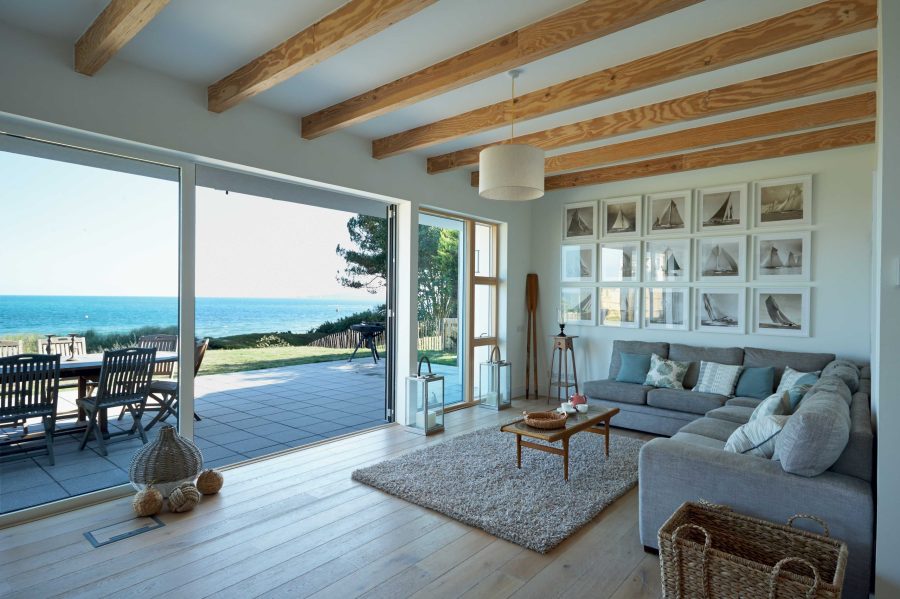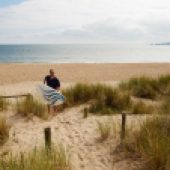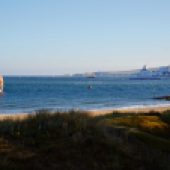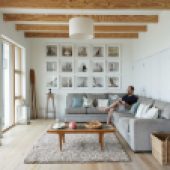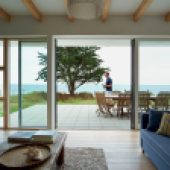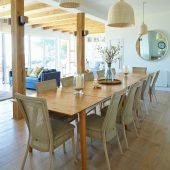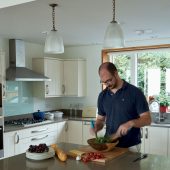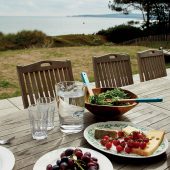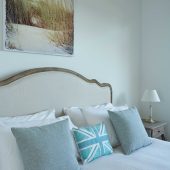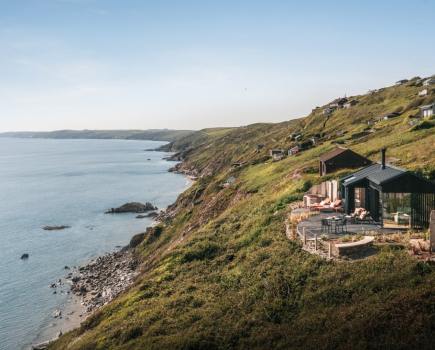When the Baldwin family decided to rebuild their holiday home at Sandbanks on the Dorset coast, they wanted to ensure that the property would be perfect for generations to come. Words: Alex Fisher. Photographs: Paul Ryan-Goff
My whole life has been influenced by my summers at Hook Sands,’ says Tim Baldwin, as he gazes across the English Channel. ‘The close relationship I built with the sea led me to become a yacht skipper, and then study yacht design. It has fundamentally shaped my entire career.’ Hook Sands was the name of the original bungalow that once stood on his family plot at Sandbanks, and the name the recent rebuild retains: ‘We could change everything,’ he explains, ‘but we couldn’t change the name. It holds too many childhood memories.’
Tim’s family bought a plot at Sandbanks, one of the most expensive stretches of coastline in the British Isles, when the land was worthless. ‘My great-grandfather paid next to nothing for it 100 years ago. Sandbanks wasn’t popular then. No one built on sand.’ But they couldn’t have been more wrong. The prices for a detached house on this sandy spit now range between £3 and £7 million pounds.
SUMMER RETREAT
‘My grandmother holidayed here throughout her childhood,’ Tim continues, ‘and when she and her siblings left home and had their own children, my great-grandfather made sure they all continued to spend their summers here together.’
The original Hook Sands was built in the Twenties and this property ensured that Tim followed in his mother’s footsteps, spending all his childhood holidays on this sandy spit. ‘We never went abroad, all our extended family came here: cousins, aunts, uncles – there was enough room for everyone. It allowed us to become real friends, not just relatives. I did the same things my mother did. I learnt to sail, went crabbing and shrimping, and I hope my children will do the same things too. It has given our family an incredible bond and sense of continuity.’
So the decision to knock the original bungalow down and build a new holiday home was not an easy one. ‘The old Hook Sands was a higgledy-piggledy patchwork of extensions, it really needed to come down, but we all had to participate in the redesign and be happy with the outcome. It was so close to our hearts, we were wary of getting it wrong. As a result we looked at eight different architects before agreeing on how to go forward.’
The practice the Baldwin family finally chose was HÛT, a London-based company known for its environmental sensitivity. ‘Their previous work was very in keeping with its surroundings, and that is an essential thing when you are building a new house at such a stunning natural location. They have an extremely sympathetic way of creating contemporary design, whilst also making a home. We were impressed by the amount of work they did for the pitch and we felt like they understood what we wanted. They stretched our ideas, without overrunning them. We, in turn, tried to give them space to breathe.’
Liam Saunders, the Project Architect from HÛT, says: ‘In the initial stages we met with Tim, his sister Lucinda, and his father Jonathan. They were all hands-on with the design. It was a very inclusive process, amongst family members, and between us.
‘There is an eclectic mix of properties along Banks Road now and they made it clear they didn’t want the Miami-style glass and stainless steel that have become fashionable; they wanted something more down-to-earth, something traditional, but with a Scandinavian slant.’
A HOME FOR ALL SEASONS
The result is a beautiful, larch-clad house, which seems to blend into the sand dunes it sits upon. ‘We chose untreated larch for the cladding,’ says Liam, ‘so that it would change with the weather and the seasons, just like the landscape.
In five to ten years, this timber will be even more beautiful, taking on the colours of driftwood, weathered by the sun and the salt from the sea.’
Environmental considerations were important to both parties. However, rather than incorporating hi-tech eco-gadgets into the design, they drew upon traditional low-tech principles, such as an overhanging roof, which provides shade in the summer, and protection in the winter, windows that maximise passive solar performance of the house, and enormously thick walls, made from air-filled blocks, covered insulation and cladding, which keep the property cool in the summer and warm in the winter. They also reinstated the natural habitat of the local sand lizard population in the garden after the build was completed.
THE PERFECT BLEND
‘What we now have,’ Tim says, ‘is a property that doesn’t impose itself on the landscape, rather, we hope, over the years it will blend in even more naturally with the dunes.’
Throughout the design process there had to be an awareness of how the sea could impact on the building: salt, water and wind can play havoc with many common building materials and practices. ‘Obviously,’ says Liam, ‘from a design point of view we maximised habitable rooms with views out to sea, but there were also practical concerns. We used marine-grade coatings for the aluminium windows and made the building airtight, so that it would be warm and comfortable when there were strong winds.’
Employing an architect and designing a house from scratch can be a daunting prospect. However, both HÛT and the Baldwins say that the key to a smooth, problem-free build, is planning. ‘As a designer myself, I knew we had to do a lot of preparation beforehand. My sister, father and mother were all involved, and we wanted it to represent all of our wishes,’ says Tim, who now runs his own interior design company, Baldwin Harris, which creates bespoke interiors for luxury yachts and homes. Liam confirms that making all the decisions before the building process starts is essential to meeting deadlines.
‘The build was meant to take nine months and we only went five days over, due to bad weather. We also benefited from a great building firm, Westgate Construction, who were incredibly organised, as well as being passionate about quality and realising the architectural details.
‘We now have a holiday home that will last for generations to come,’ says Tim. ‘Our greatest luxury is space, not gadgets and gimmicks: the size of the rooms and corridors, the quality of the materials used and the light from the large windows. I can look forward to teaching my daughter to sail here, just as my mother did, just as I did.’
HÛT, 3rd Floor, 35-39 Old Street, London EC1V 9HX (020 7399 8680, hutarchitecture.com).
HÛT’s five top tips for choosing and working with an architect
1 When considering an architect, talk to past clients and see completed work. Happy clients often love to show off their homes and talk about the experience.
2 Choose an architect on the basis of their portfolio and the individuals you think you are going to enjoy working with over the coming months or years. It is an intimate working relationship that you will develop together so this is far more important than just choosing on the basis of fees. You could be working together for a long time.
3 Give yourselves and your architect plenty of time to work through lots of ideas, and make sure you explore them in different ways with sketches, models, visuals, samples, mock-ups, as well as drawings. Time also allows your architect to produce a thorough costing/construction package. The more considered and detailed the information is, the less likely you are to encounter cost increases or time overruns when work starts on site.
4 Obviously you may want to change a few aspects of the project as it is being built but try to keep changes to a minimum when the project is on site; this is when projects go over budget and schedule. Often the contractor will have already ordered materials and planned labour so a small change can sometimes have a big impact.
5 Enjoy the process. Working with an architect to build a new home, or remodel an existing one is a wonderful opportunity to create something unique that you, your family and friends will enjoy for years to come.
When the Baldwin family decided to rebuild their holiday home at Sandbanks on the Dorset coast, they wanted to ensure that the property would be perfect for generations to come. Words: Alex Fisher. Photographs: Paul Ryan-Goff
My whole life has been influenced by my summers at Hook Sands,’ says Tim Baldwin, as he gazes across the English Channel. ‘The close relationship I built with the sea led me to become a yacht skipper, and then study yacht design. It has fundamentally shaped my entire career.’ Hook Sands was the name of the original bungalow that once stood on his family plot at Sandbanks, and the name the recent rebuild retains: ‘We could change everything,’ he explains, ‘but we couldn’t change the name. It holds too many childhood memories.’
Tim’s family bought a plot at Sandbanks, one of the most expensive stretches of coastline in the British Isles, when the land was worthless. ‘My great-grandfather paid next to nothing for it 100 years ago. Sandbanks wasn’t popular then. No one built on sand.’ But they couldn’t have been more wrong. The prices for a detached house on this sandy spit now range between £3 and £7 million pounds.
SUMMER RETREAT
‘My grandmother holidayed here throughout her childhood,’ Tim continues, ‘and when she and her siblings left home and had their own children, my great-grandfather made sure they all continued to spend their summers here together.’
The original Hook Sands was built in the Twenties and this property ensured that Tim followed in his mother’s footsteps, spending all his childhood holidays on this sandy spit. ‘We never went abroad, all our extended family came here: cousins, aunts, uncles – there was enough room for everyone. It allowed us to become real friends, not just relatives. I did the same things my mother did. I learnt to sail, went crabbing and shrimping, and I hope my children will do the same things too. It has given our family an incredible bond and sense of continuity.’
So the decision to knock the original bungalow down and build a new holiday home was not an easy one. ‘The old Hook Sands was a higgledy-piggledy patchwork of extensions, it really needed to come down, but we all had to participate in the redesign and be happy with the outcome. It was so close to our hearts, we were wary of getting it wrong. As a result we looked at eight different architects before agreeing on how to go forward.’
The practice the Baldwin family finally chose was HÛT, a London-based company known for its environmental sensitivity. ‘Their previous work was very in keeping with its surroundings, and that is an essential thing when you are building a new house at such a stunning natural location. They have an extremely sympathetic way of creating contemporary design, whilst also making a home. We were impressed by the amount of work they did for the pitch and we felt like they understood what we wanted. They stretched our ideas, without overrunning them. We, in turn, tried to give them space to breathe.’
Liam Saunders, the Project Architect from HÛT, says: ‘In the initial stages we met with Tim, his sister Lucinda, and his father Jonathan. They were all hands-on with the design. It was a very inclusive process, amongst family members, and between us.
‘There is an eclectic mix of properties along Banks Road now and they made it clear they didn’t want the Miami-style glass and stainless steel that have become fashionable; they wanted something more down-to-earth, something traditional, but with a Scandinavian slant.’
A HOME FOR ALL SEASONS
The result is a beautiful, larch-clad house, which seems to blend into the sand dunes it sits upon. ‘We chose untreated larch for the cladding,’ says Liam, ‘so that it would change with the weather and the seasons, just like the landscape.
In five to ten years, this timber will be even more beautiful, taking on the colours of driftwood, weathered by the sun and the salt from the sea.’
Environmental considerations were important to both parties. However, rather than incorporating hi-tech eco-gadgets into the design, they drew upon traditional low-tech principles, such as an overhanging roof, which provides shade in the summer, and protection in the winter, windows that maximise passive solar performance of the house, and enormously thick walls, made from air-filled blocks, covered insulation and cladding, which keep the property cool in the summer and warm in the winter. They also reinstated the natural habitat of the local sand lizard population in the garden after the build was completed.
THE PERFECT BLEND
‘What we now have,’ Tim says, ‘is a property that doesn’t impose itself on the landscape, rather, we hope, over the years it will blend in even more naturally with the dunes.’
Throughout the design process there had to be an awareness of how the sea could impact on the building: salt, water and wind can play havoc with many common building materials and practices. ‘Obviously,’ says Liam, ‘from a design point of view we maximised habitable rooms with views out to sea, but there were also practical concerns. We used marine-grade coatings for the aluminium windows and made the building airtight, so that it would be warm and comfortable when there were strong winds.’
Employing an architect and designing a house from scratch can be a daunting prospect. However, both HÛT and the Baldwins say that the key to a smooth, problem-free build, is planning. ‘As a designer myself, I knew we had to do a lot of preparation beforehand. My sister, father and mother were all involved, and we wanted it to represent all of our wishes,’ says Tim, who now runs his own interior design company, Baldwin Harris, which creates bespoke interiors for luxury yachts and homes. Liam confirms that making all the decisions before the building process starts is essential to meeting deadlines.
‘The build was meant to take nine months and we only went five days over, due to bad weather. We also benefited from a great building firm, Westgate Construction, who were incredibly organised, as well as being passionate about quality and realising the architectural details.
‘We now have a holiday home that will last for generations to come,’ says Tim. ‘Our greatest luxury is space, not gadgets and gimmicks: the size of the rooms and corridors, the quality of the materials used and the light from the large windows. I can look forward to teaching my daughter to sail here, just as my mother did, just as I did.’
HÛT, 3rd Floor, 35-39 Old Street, London EC1V 9HX (020 7399 8680, hutarchitecture.com).
HÛT’s five top tips for choosing and working with an architect
1 When considering an architect, talk to past clients and see completed work. Happy clients often love to show off their homes and talk about the experience.
2 Choose an architect on the basis of their portfolio and the individuals you think you are going to enjoy working with over the coming months or years. It is an intimate working relationship that you will develop together so this is far more important than just choosing on the basis of fees. You could be working together for a long time.
3 Give yourselves and your architect plenty of time to work through lots of ideas, and make sure you explore them in different ways with sketches, models, visuals, samples, mock-ups, as well as drawings. Time also allows your architect to produce a thorough costing/construction package. The more considered and detailed the information is, the less likely you are to encounter cost increases or time overruns when work starts on site.
4 Obviously you may want to change a few aspects of the project as it is being built but try to keep changes to a minimum when the project is on site; this is when projects go over budget and schedule. Often the contractor will have already ordered materials and planned labour so a small change can sometimes have a big impact.
5 Enjoy the process. Working with an architect to build a new home, or remodel an existing one is a wonderful opportunity to create something unique that you, your family and friends will enjoy for years to come.

